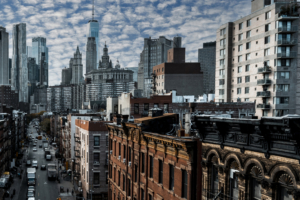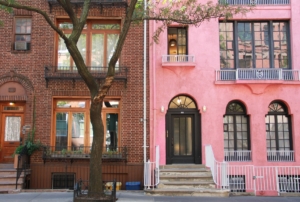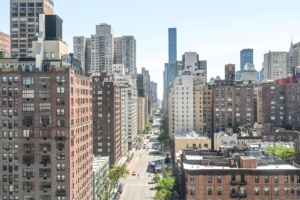The next time you feel crowded in your New York City apartment, remember this: you’re not alone. As the city’s 8.26 million inhabitants course through Gotham’s subways, streets and plazas, they are far more likely than their fellow Americans to return home to a crowded apartment.
Let’s start with the definition of crowded. According to the U.S. Census Bureau, a crowded household is one in which there is more than one person per room. A severely crowded household is one in which there is more than 1.5 persons per room. The number of rooms may not be the same as the number of bedrooms. For example, a living room or dining room are most often considered rooms. In effect, a couple living in a studio apartment would be considered severely crowded (two persons per room), while that same couple living in a one-bedroom apartment wouldn’t be considered crowded at all (less than one person per room). As any couple can attest, that extra room can be important.
According to 2013 Census data, 8.9 percent of all New York City households met the definition of “crowded” in 2013, whereas just 3.3 percent of all U.S. households were crowded.[i] Among the five boroughs, the Bronx saw the highest percentage of crowded households (12.4 percent), followed by Brooklyn (10.3 percent) and Queens (9.4 percent). Households were less congested in Manhattan and Staten Island by comparison, where just 5.4 percent and 3.4 percent of all households were crowded in 2013, respectively.
A look at crowding rates by neighborhood reveals that households are the most crowded in the South Bronx, Central Queens and South Brooklyn areas of the city. Use the map below to see 2013 crowding rates by neighborhood.
[tableau server=”public.tableau.com” workbook=”OvercrowdingAnalysis” view=”crowdingMapExperiment” tabs=”no” toolbar=”no” revert=”” refresh=”yes” linktarget=”” width=”600px” height=”1200px”][/tableau]
Queens: The World’s (Crowded) Borough
Although the Bronx leads all boroughs in the share of crowded households, the neighborhoods with the highest crowding rates were located in Queens, a borough that is described as “the world’s borough” because of its remarkable racial and ethnic diversity. The role that Queens serves as a steppingstone to the United States for immigrant families is in full view with the borough’s crowding rate: 9.4 percent of all households were crowded in 2013, slightly higher than in New York overall.
Corona, East Elmhurst and Jackson Heights each had a crowding rate that exceeded 20 percent, making them the most crowded neighborhoods of New York City in 2013. Perhaps not coincidentally, these neighborhoods also had the highest percentage of immigrants in the city. According to a recent report published by the city comptroller, 64 percent of Elmhurst/Corona residents are immigrants. In Jackson Heights, the share is 62 percent.
Below is a list of the 10 most crowded neighborhoods[1]:
| Neighborhood | Borough | % of crowded households |
| Corona | Queens | 23.0% |
| North Corona | Queens | 20.8% |
| East Elmhurst | Queens | 20.7% |
| Jackson Heights | Queens | 20.6% |
| Crotona Park East | Bronx | 19.6% |
| Windsor Terrace | Brooklyn | 19.6% |
| Sunset Park | Brooklyn | 19.6% |
| Morrisania | Bronx | 19.4% |
| East Tremont | Bronx | 18.8% |
| Belmont | Queens | 18.7% |
Doubling Down on Doubling Up
While Queens has some of the most crowded neighborhoods in New York City, Brooklyn is home to neighborhoods that have seen some of the highest growth in crowding recently. Five of the top 10 neighborhoods with the highest growth in crowding rates are located in Brooklyn, while Queens has four. See the full list of neighborhoods that have seen the greatest increase in crowding since 2010 below:
| Neighborhood | Borough | 2010 | 2013 | 3-year change |
| Kingsbridge | Bronx | 6.2% | 12.3% | 6.1% |
| Corona | Queens | 17.2% | 23.0% | 5.8% |
| Manhattan Beach | Brooklyn | 4.2% | 10.0% | 5.8% |
| Gerritsen Beach | Brooklyn | 4.2% | 10.0% | 5.8% |
| Sheepshead Bay | Brooklyn | 4.7% | 9.6% | 4.9% |
| Bath Beach | Brooklyn | 7.8% | 12.3% | 4.5% |
| Bensonhurst | Brooklyn | 7.8% | 12.3% | 4.5% |
| Fresh Meadows | Queens | 6.2% | 10.2% | 4.0% |
| Hillcrest | Queens | 6.2% | 10.2% | 4.0% |
| Pomonok | Queens | 6.2% | 10.2% | 4.0% |
Several neighborhoods in South Brooklyn and Queens have become more crowded in recent years, despite the opposite trend in New York City overall. Between 2010 and 2013, the city’s crowding rate fell from 9.2 percent to 8.9 percent. In these neighborhoods, residents have doubled down on doubling up in recent years, most likely to lower their housing cost burden as the price of rent increases across the city.
Higher Rent Burden Fuels Crowding
According to our recent forecast of rent prices, the typical New York household will need to spend a staggering 65.4 percent of its annual income on median asking rent in 2016, up from 58.4 percent in 2015. The reason for this growing burden lies in stagnant income growth and higher rents. While the median asking rent is expected to grow by 3.2 percent to $3,055 in 2016, the median household income is expected to grow by just 0.7 percent to $56,079. As rent price growth continues to outpace income growth, a greater share of the typical New Yorker’s monthly paycheck will need to go towards rent.
One way that New Yorkers address the increasing burden is to search for a roommate – or two or three. Indeed, the neighborhoods with the highest median rent-to-income ratio[ii] often have the highest rates of crowding, suggesting a rather close correlation between rent burden and the need to double or triple up on roommates.
Neighborhoods in which the median rent-to-income ratio was above 50 percent in 2015 are more likely to be crowded, as the box plot below illustrates.
[tableau server=”public.tableau.com” workbook=”Boxplot2″ view=”neighborhoodWindow” tabs=”no” toolbar=”no” revert=”” refresh=”yes” linktarget=”” width=”600px” height=”670px”][/tableau]
If You Can Fit Here, You Can Fit Anywhere
People from near and far come to New York City to build careers, lives, and futures for themselves and their families. But it is often said that living in New York City requires trade-offs, and this is certainly the case when it comes to the balance between personal space and affordable rent. As demand for housing increases across the five boroughs, New Yorkers face higher prices and, absent an increase in their pay, they face a greater rent burden as well. Many New Yorkers trade space for affordability, showing us that if you can fit in New York City, you may just be able to fit anywhere.
[1] According to 2013 census data
[i] U.S. Census Bureau, 2013 ACS 5-Year Estimate, and the Office of the New York City Comptroller – Hidden Households Report
[ii] Rent-to-income ratio represents the share of a household’s monthly income that is spent on rent. Neighborhood rent-to-income ratio is calculated by dividing 2013 median asking rent by 2013 median household income.








